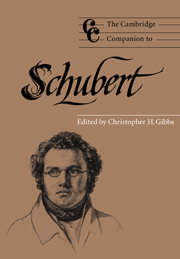Book contents
- Frontmatter
- Introduction: the elusive schubert
- Part I Contexts: musical, political, and cultural
- Part II Schuberts music: style and genre
- 6 Schubert's songs: the transformation of a genre
- 7 Schubert's social music: the “forgotten genres”
- 8 Schubert's piano music: probing the human condition
- 9 Schubert's chamber music: before and after Beethoven
- 10 Schubert's orchestral music: “strivings after the highest in art”
- 11 Schubert's religious and choral music: toward a statement of faith
- 12 Schubert's operas: “the judgment of history?”
- Part III Reception
- Notes
- Index
10 - Schubert's orchestral music: “strivings after the highest in art”
from Part II - Schuberts music: style and genre
Published online by Cambridge University Press: 28 September 2011
- Frontmatter
- Introduction: the elusive schubert
- Part I Contexts: musical, political, and cultural
- Part II Schuberts music: style and genre
- 6 Schubert's songs: the transformation of a genre
- 7 Schubert's social music: the “forgotten genres”
- 8 Schubert's piano music: probing the human condition
- 9 Schubert's chamber music: before and after Beethoven
- 10 Schubert's orchestral music: “strivings after the highest in art”
- 11 Schubert's religious and choral music: toward a statement of faith
- 12 Schubert's operas: “the judgment of history?”
- Part III Reception
- Notes
- Index
Summary
Schubert inherited the attitude from the end of the eighteenth century that to succeed as a composer – both commercially and artistically – one had to write good operas and symphonies. Throughout his life he turned and returned to these two genres, despite his realization that no throng of listeners, not even his most ardent fans and friends, requested such compositions of him. Schubert felt that he needed to go beyond the confines of the song, piano piece, and chamber work in order to link his name to those of Haydn, Mozart, and, especially, his greatest contemporary, Beethoven. In February 1828, just nine months before his death, Schubert informed the publisher B. Schott's Söhne of his available compositions. In this letter he lists various chamber compositions, works for piano solo and duet, songs for one or more voices, and choral works. After all this, however, he reveals his creed as a composer: “This is the list of my finished compositions, excepting three operas, a Mass and a symphony. These last compositions I mention only in order to make you acquainted with my strivings after the highest in art” (SDB 739–40).
It was rare for Schubert to discuss his symphonies in his correspondence. One senses that, although his aims may have been pragmatic in the case of opera, they were idealistic in connection with the symphony, and that, perhaps, his most important artistic goal was to compose a remarkably fine symphony – a great symphony – to match the symphonic accomplishments of Beethoven.
- Type
- Chapter
- Information
- The Cambridge Companion to Schubert , pp. 193 - 206Publisher: Cambridge University PressPrint publication year: 1997
- 4
- Cited by



